Asclepias syriaca, common milkweed, is a big native perennial herbaceous plant that blooms in the summer and is frequently associated with Monarch butterflies. Milkweeds have an unusual flower anatomy which results in unusual pollination techniques. Wildlife is rewarded with its rich supply of nectar.
Flowers
Inflorescence/Flower cluster:
The big flower clusters emerge from near the top of the stem from the axils of the upper leaves. The clusters are about 2 to 4 inches across and can have up to 100 flowers each. All the flowers in the cluster originate from a single point and is called an umbel. Each stem can have 1 to 3 clusters. The flowering lasts about 1-1½ months from early to mid-summer.
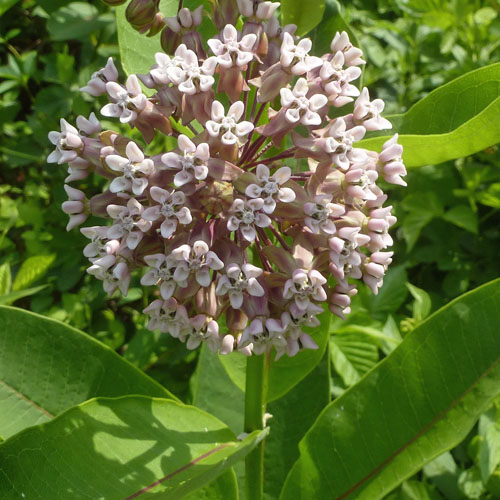

Individual Flower:
The Asclepias syriaca flower has both male and female parts. It has a corolla that separates out to 5 petals and a 5 parted calyx (sepals). The flowers are a pale light pink to pale reddish purple. Each flower is about a quarter inch across. When the flowers are mature, the petals are reflexed.
If you look at the individual flowers, you will easily notice it does not look like a traditional flower.
Flower structure of the common milkweed. Actually, all the milkweeds have similar structure. The petals are easily recognized.
In the labeled photo below, inside the petals is a circle of 5 hoods each containing a horn. The hoods hold nectar which attracts insects. These hoods encircle the gynostegium. The gynostegium is a column of partially fused stamens and the pistil. There are 5 stamens.
The anthers, surrounding the outside of the gynostegium, are split in half with a slit in between each half, called the stigmatic slit. Instead of individual pollen grains, the grains are together in a sac called the pollinium. There is a pollinium(pollen sac) in each anther pouch on each side of the slit. The pollinia(pollen sacs) are connected to the corpusculum, the black looking object, by connectors called translator arms. These three parts together are called pollinaria.
Now for the female parts. In the gynostegium are 5 receptive stigmatic surfaces that are inside of 5 stigmatic chambers. Access to the receptive stigmatic surfaces is through the stigmatic slits. Interestingly, the flower has two ovaries and 2 stigmatic chambers is connected to one ovary and 3 stigmatic chambers to the other ovary.
 Thanks to Belinda Beetham for the detailed photo to which I was able to add labels.
Thanks to Belinda Beetham for the detailed photo to which I was able to add labels.
Here, the slit and corpusculum is more visible and the corolla is reflexed. Note: sometimes the tip of the hood has lobes. The petals are maroonish and the hoods and horns are whitish.
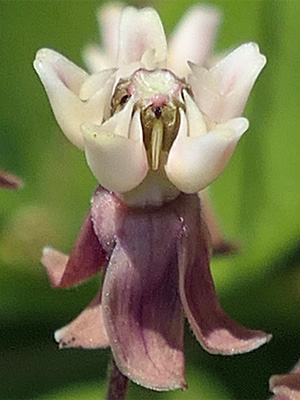
The outer surface of the petals and the flower stalks are hairy.
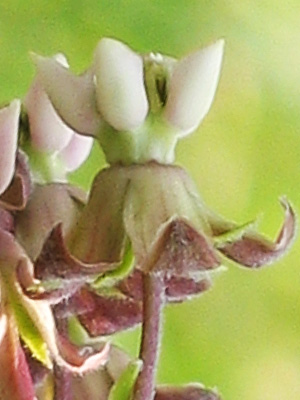
Pollination
Asclepias syriaca, common milkweed, has a copious supply of high quality nectar that is readily accessible in the hoods. It also has a large supply of pollen. However, the pollen is encapsulated in the pollinium and is not accessible to flower visitors. So nectar is the only reward that the milkweeds offer to pollinating insects.
Common milkweed, with its complicated flower structure, requires that its pollinating insects be compatible with the flower structure. When the nectar seeking insect is feeding on nectar around the hoods, one of its legs may slide into one of the slits. In the process of removing its leg, the corpusculum gets stuck on the leg. Then entire pollinaria gets pulled out; the 2 translators, and pollinium (pollen sac) pair out of the anther pouches. Sometimes insects will get stuck on the flower because they can't get their leg out or they would lose a leg, especially smaller insects. Larger insects like bumble bees and honey bees are more likely to be successful at extracting the pollinium apparatus without loss of legs. Then the insects may continue to collecting nectar and inadvertently collect more pollinaria.
With the pollinaria dangling from their legs, the insect will fly around and some pollinaria will just drop off. However some of the pollinaria will be taken to another milkweed flower. The translator arm will orient the pollinium so that it slides into the stigmatic slit and into the stigmatic chamber when the insect is oriented properly over the flower. Amazing! The pollinium breaks off, the translator arm is broken, and the corpusculum remains on the insect. If an insect is inspected, one can count the remaining corpuscula to determine how many deliveries it had made.
Inside the stigmatic chamber, the pollinium makes contact with the stigmatic surface and pollination processes occur. The plant is not self-fertile, so the pollinia must come from a genetically different plant in order to have seed set. Since this milkweed plant sends out rhizomes, nearby plants may be clones and the pollinating insects may need to come from further away.
Fruit
Since seed production requires a lot of energy and there would not be enough resources for all the pollinated flowers to set seed. So, only one or two of the pollinated flowers develop into mature seed pods (follicles). All the other flowers are aborted.
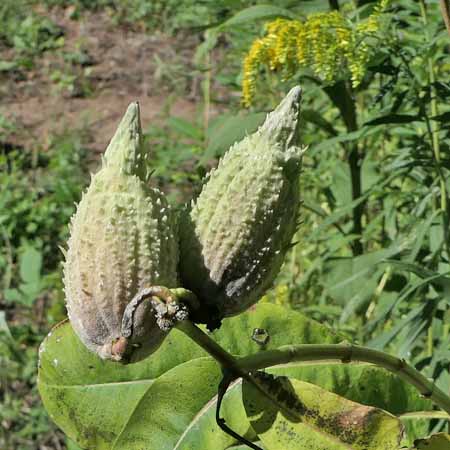
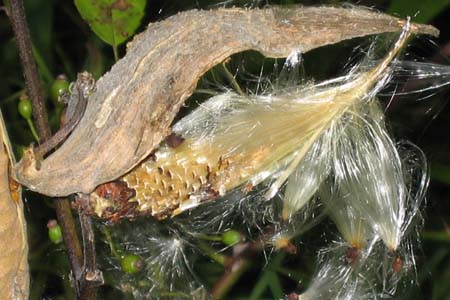
Plant - Leaves - Habitat
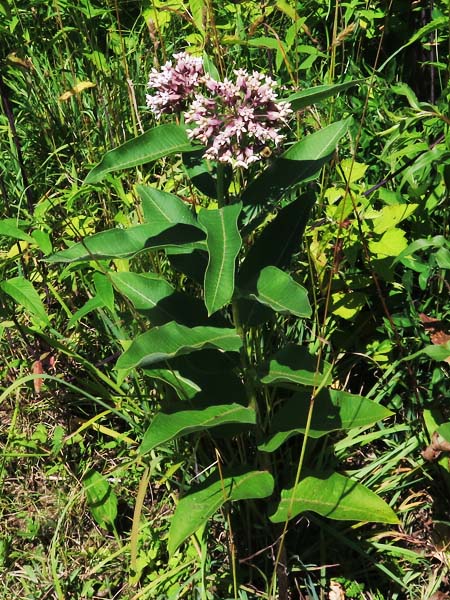 The common milkweed plant is a large upright perennial 2 to 6 ft. tall and not branched until near the top where the flowers occur. The stem is sturdy, pale green, and usually short-pubescent or smooth. The plant, grows a network of thick rhizomes (horizontal underground stems) which send out shoots and roots for new plants.
The common milkweed plant is a large upright perennial 2 to 6 ft. tall and not branched until near the top where the flowers occur. The stem is sturdy, pale green, and usually short-pubescent or smooth. The plant, grows a network of thick rhizomes (horizontal underground stems) which send out shoots and roots for new plants.
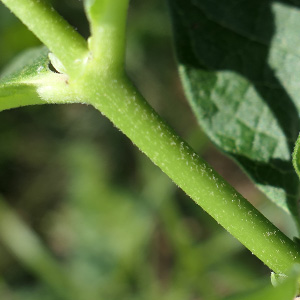
When the leaves or stems are broken, they produce a milky latex. This liquid contain various levels of toxic cardiac glycoside compounds which makes the plants toxic to most insects and animals. However, for some insects, the cardiac glycosides become a defense mechanism.
The leaves are simple, opposite with short petioles (leaf stalks) or sessile.
They are oblong (rectangular with rounded ends) to elliptic (broadest in the middle). The thick leaves are large, up to 8" long and 3.5" across. The edges are smooth but frequently undulate(wavy).
The upper surface is light to dark green and hairless or slightly hairy and the lower surface lighter green and densely hairy.
The leaf has a prominent midrib. The midrib may be red-brownish sometimes. The many smaller veins extending from the midrib to almost the edge have a distinctive pattern with the veins almost parallel to each other and perpendicular to the midrib.
Leaf shapes and venation pattern
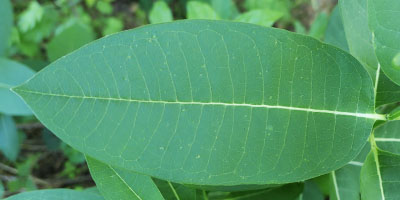
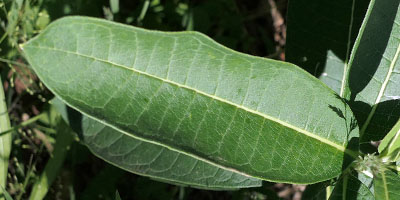

Lighter green underside and dark green top surface (bottom leaves) Petiole (leaf stalk) is easily seen.
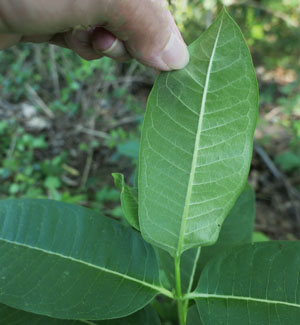
Fuzzy hairs on the underside.
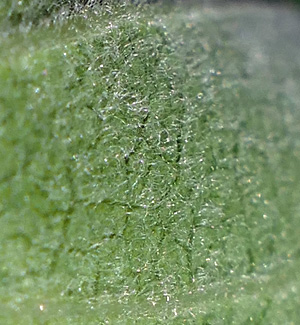
The habitat includes meadows and sunny areas.
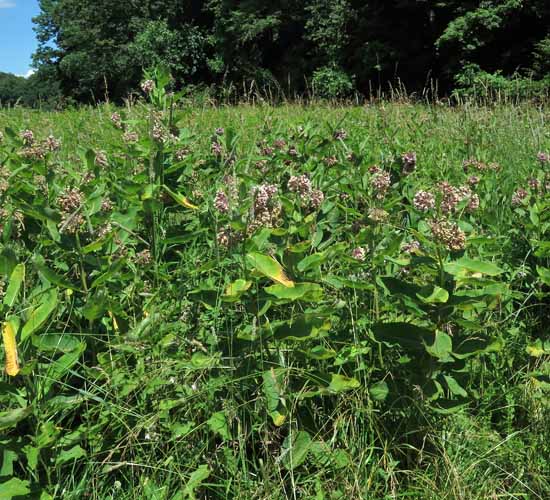
It has been found that over 450 species of insects feed on some portion of common milkweed. It provides nectar for flies, beetles, ants, bees, wasps, and butterflies and other insects.
Even though the milkweeds contain various levels of cardiac glycoside compounds which make the plants toxic to most insects and animals, some insects can store these chemicals in their tissue so that they are not edible by other animals. The Monarch butterflies do this, so that birds do not eat them or their caterpillars.
Some birds use the milkweed fiber to make their nests. Some birds use the milkweed silky seed tufts to line their nests.
Text by Millie Ling and all photos by Hubert & Millie Ling. Photos: Summer, Sourlands, Whittingham WMA, Delaware & Raritan Canal, Kittatinny Valley State Park, cultivation. Common milkweed can be found in many places.
Cultivation
The cultivation material below is courtesy of
Jersey Friendly Yards searchable plant database: Asclepias syriaca
In NJ it blooms Late Spring to Early Summer, Summer
Hardiness Zone: 6a, 6b, 7a, 7b
Physiographic Region: All Regions in NJ
Salt Tolerance: Low to None
Soil Type: Loam, Organic, Sandy, Clay
Soil Moisture: Dry
Drought Tolerance: High
Soil pH: Slightly Acidic, Neutral
Optimal Light: Full Sun
Light Range: Full Sun, Partial Shade
Growth Rate: Medium
Additional information
Additional information / references:
- The USDA website shows Asclepias syriaca distribution in the US and other information: https://plants.sc.egov.usda.gov/home/plantProfile?symbol=ASSY
- USDA plant of the week: https://www.fs.usda.gov/wildflowers/plant-of-the-week/asclepias_syriaca.shtml
- USDA Milkweed Pollination Biology. https://www.nrcs.usda.gov/Internet/FSE_PLANTMATERIALS/publications/nvpmctn12764.pdf
- Minnesota Wildflowers: descriptions. https://www.minnesotawildflowers.info/flower/common-milkweed
- Milkweed - For More Than Monarch Butterflies. https://www.fws.gov/story/2016-07/milkweed-more-monarch-butterflies
- Key to NJ Milkweeds: GoBotany. https://gobotany.nativeplanttrust.org/dkey/asclepias/#all